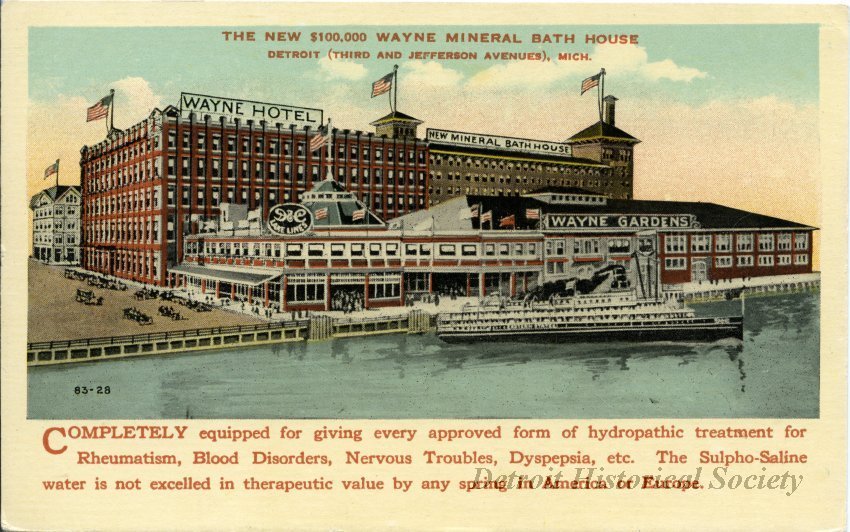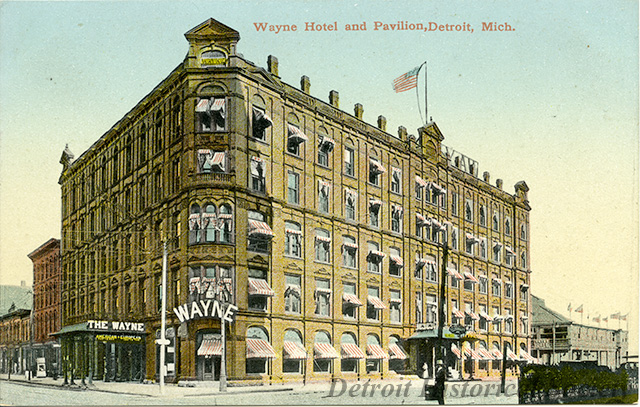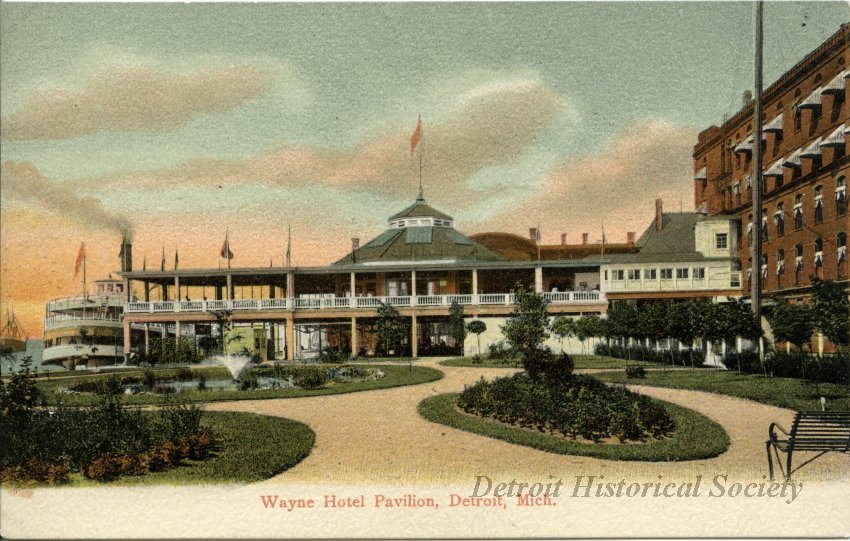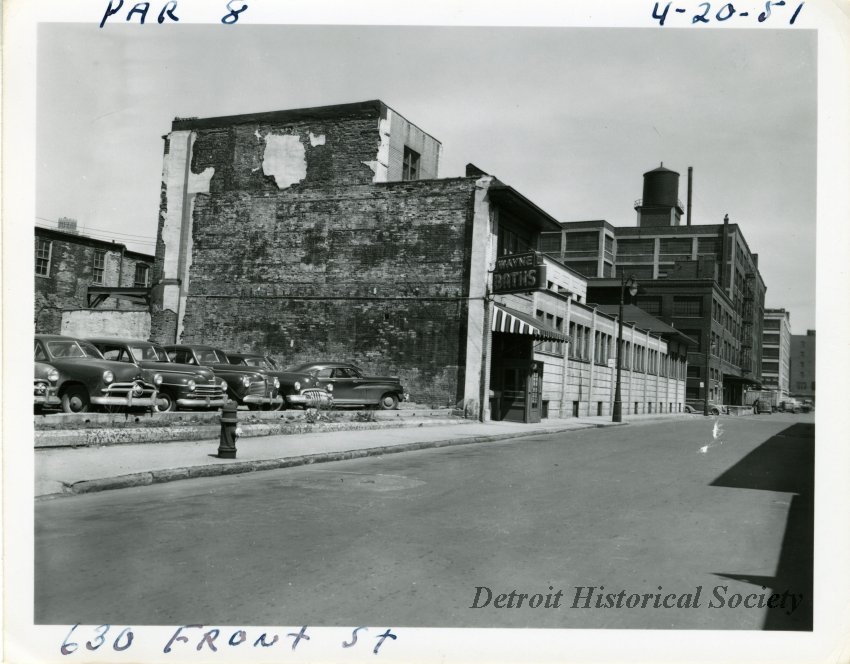Downtown’s Forgotten Resort
 In addition to the original structure, and the Wayne Gardens, this c. 1915 postcard shows a planned six-story addition to the complex, which was to follow the construction of the two-story mineral baths.
In addition to the original structure, and the Wayne Gardens, this c. 1915 postcard shows a planned six-story addition to the complex, which was to follow the construction of the two-story mineral baths.
For much of Detroit’s history, the downtown riverfront was a place of industry. However, around the turn of the last century, amid the docks and warehouses, one short street was home to a lavish hotel and mineral baths. Front Street ran a mere two and a half blocks between Cass and Third Street, just one block north of the river. This stretch was a compact transportation hub, bordering both the Michigan Central Railroad Depot on the west and steamboat docks to the south and east. Between these points, on the northeast corner of Front and Third Streets, was Front Street’s centerpiece, the Wayne Hotel, a luxurious establishment which catered to rail and lake travelers.
 This c. 1910 postcard captures the Jefferson Avenue and Third Street faces of the Wayne Hotel. In the background at the right, the Wayne Pavilion stands on the south side of Front Street.
This c. 1910 postcard captures the Jefferson Avenue and Third Street faces of the Wayne Hotel. In the background at the right, the Wayne Pavilion stands on the south side of Front Street.
The Wayne Hotel opened in 1887 with 187 rooms across five floors. Daily rates ran between $2 and $3.50. In the following years, the successful hotel underwent several expansions. The hotel’s first significant addition came in 1898, when the Wayne Hotel Riverfront Pavilion was opened on the south side of Front Street. This connected the hotel to the docks used by the Belle Isle ferries. The Pavilion also provided space for a host of activities, including ice and roller skating, concerts and conventions. By 1909, the Pavilion had grown into the Wayne Hotel Gardens. This improved facility hosted the Detroit Auto Dealers’ Association auto shows between 1909 and 1913. In 1915 the hotel expanded yet again, with the additional of mineral baths contained in a two-floor structure on the southeastern corner of the block. From wells deep below the riverfront, the baths drew sulfur-rich water which purportedly could sooth conditions ranging from rheumatism to “nervous troubles.”
 In 1896, the Wayne Hotel expanded across Front Street with the Wayne Pavilion, featured on this c. 1907 postcard.
In 1896, the Wayne Hotel expanded across Front Street with the Wayne Pavilion, featured on this c. 1907 postcard.
However, this era proved to be the zenith for the Wayne Hotel. By 1910, the auto show’s planners were already complaining of a lack of space at the Wayne Gardens. The 1912 and 1913 shows necessitated the construction of increasingly large temporary annexes to accommodate all of the exhibits. For the 1914 show, planners abandoned the hotel completely for the Ford branch building at Woodward and East Grand Boulevard. The most significant blow to the hotel came that same year when the Michigan Central Railroad Depot closed in favor of the company’s massive new station off of Michigan Avenue. In 1918, the hotel’s longtime proprietor James R. Hayes filed for bankruptcy. The hotel’s fixtures were sold off at auction as Hayes fell into poor health. Hayes weathered both the bankruptcy and illness, and before the year was out, he reopened the mineral baths as a stand-alone business—the Wayne Baths—as it was profitable even without the influx of rail passengers. With the city facing a housing shortage, Mayor James Couzens proposed turning the now abandoned Wayne Hotel into temporary dormitories. During this transitional period, the once stately hotel was used for storage by the Goodfellows and survived a fire. In the early 1920s, the former hotel settled into a new identity as the Railway Exchange Building, housing the offices of several railroad firms. Meanwhile, the Detroit and Cleveland Navigation Company expanded their dock facilities to include the space formerly occupied by the Wayne Gardens. With the exception of the Wayne Baths, industry had reclaimed the strip.
 A riverfront view of the Wayne Hotel and Pavilion is offered by this detail from a 1905 panoramic photograph of the city's riverfront. The clock tower behind the hotel belonged to the Michigan Central Railroad Depot. The Depot's 1913 closure was a prime contributor to the hotel’s bankruptcy.
A riverfront view of the Wayne Hotel and Pavilion is offered by this detail from a 1905 panoramic photograph of the city's riverfront. The clock tower behind the hotel belonged to the Michigan Central Railroad Depot. The Depot's 1913 closure was a prime contributor to the hotel’s bankruptcy.
The Wayne Baths continued in operation into the 1950s. But finally, in January of 1958, Detroit’s Common Council called for businesses to vacate Front Street and the surrounding blocks to make way for a new convention center. Front Street vanished from the map, beneath Cobo Hall. However the Wayne Hotel got one final gasp, when in 1962 a foul smell began emanating from one of Cobo Hall’s escalators, roughly in the spot where the bath’s mineral spring was drilled.
 The Wayne Baths survived into the 1950s. In this 1951 view along Front Street, the parking lot to the left of the Baths was where the Wayne Hotel once stood.
The Wayne Baths survived into the 1950s. In this 1951 view along Front Street, the parking lot to the left of the Baths was where the Wayne Hotel once stood.

